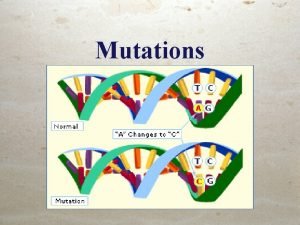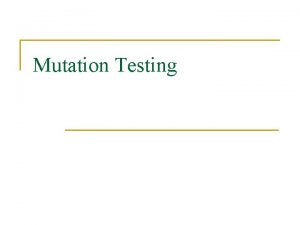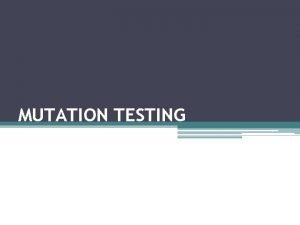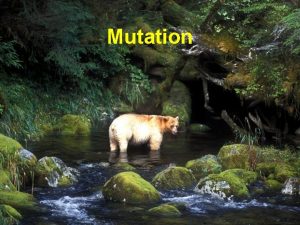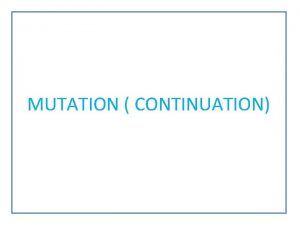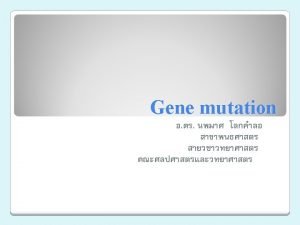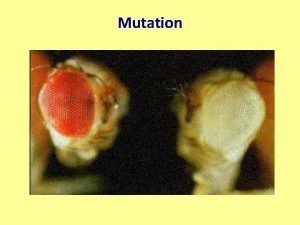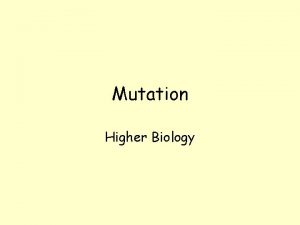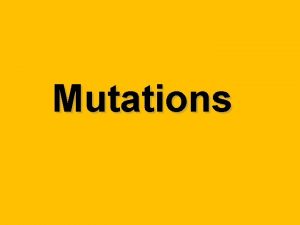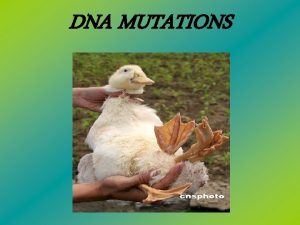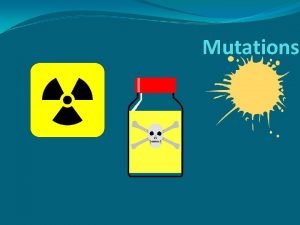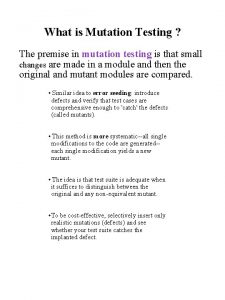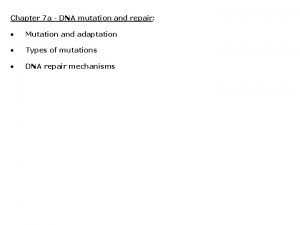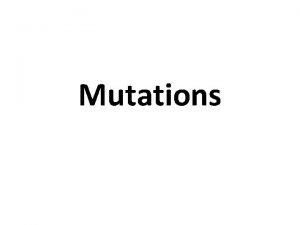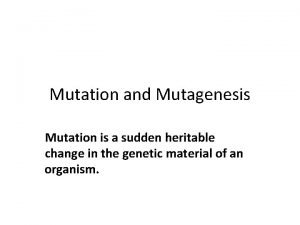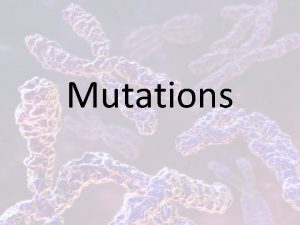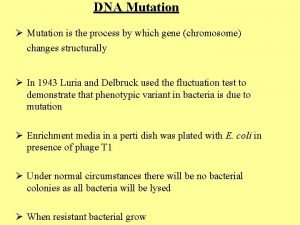Mutation A mutation is a change in the


























































- Slides: 58



Mutation A mutation is a change in the normal base pair sequence מוטציה – השתנות ברצף הנורמאלי של זיווגי הבסיסים Commonly used to define DNA sequence changes that alter protein function

Mutation ● DNA replication is extremely accurate, BUT… – Errors in polymerization occur – מוטציות במהלך הרפליקציה – Environmental factors, such as chemicals and ultraviolet radiation, can alter DNA – מוטציות כתוצאה מגורמים סביבתיים ● ● ● Irreversible changes to the cellular DNA can be lethal שינויים לא הפיכים יכולים להיות קטלנים Non-lethal changes can cause a heritable alteration of the genetic information, called a mutation Genetic changes are more noticeable in germ line cells than in somatic cells Systems exist for the repair of damaged DNA



A human DNA repair defect: Xeroderma pigmentosum Multiple skin cancers due to unrepaired UV damage to DNA

A human DNA repair defect: Bloom's syndrome


Spontaneous mutagenesis and errors in DNA replication ● ● DNA replication must accurately replicate 6 x 109 base pairs every time a human cell divides – בכל חלוקת תא יש להכפיל שישה טרליון נוקלאוטדים In man we see one new mutation per gene per 100, 000 cells per cell cycle. (spontaneous mutation frequency) –. באדם מוטציה אחת בכל מאה אלף חלוקות תא i. e. 1 error per 1010 bp incorporated

DNA polymerases have two main methods for ensuring accuracy: (a) Base selection Only AT and GC base pairs fit properly in the active site of the polymerase (b) Proofreading If a wrong base is inserted, then it is removed and replaced with the correct one before the next one is added

Induced mutagenesis Can be caused by environmental agents that damage DNA: • UV light • X-rays and g-rays • Chemical carcinogens e. g. cigarette smoke DNA damage can lead to mutations unless it is removed by DNA repair enzymes Unrepaired damage can have serious consequences


Somatic vs. germ line mutations • Somatic ( )גוף mutations can lead to cancer • Germ ( ראשוני / )נבט line mutations can lead to birth defects ( )מום מולד • Most mutations cause neither – Some fall in non-coding DNA – Others are silent רוב המוטציות אינן גורמות למחלות מכיוון שאינן פוגעות גני או - בנוקלאוטיד המעורב בתהליך התבטאות הגנים )אינטר ( אינטרונים






Natural causes of mutations מוטציות שנגרמות ע"י גורם טבעי • Base tautomerization – שינויים טאוטומרים • UV damage – נזקי קרינה • Spontaneous deamination דאמינציות





UV Radiation and Pyrimidine Dimers • UV radiation (200 -300 nm) induces the formation of dimers between adjacent thymine residues • Cytosine-cytosine and thymine-cytosine dimers occur less frequently • These pyrimidine dimers disrupt the structure of the double helix, blocking replication until the lesion is repaired



Mutations and Cancer • Mutations that affect nonessential DNA or that have negligible effects on a gene’s function are called silent mutations • Many mutations are detrimental, and a correlation exists between the accumulation of mutations and cancer • New chemicals, such as pharmaceuticals, must be tested for carcinogenic potential • Standard animal tests for carcinogenesis are lengthy and expensive • The simple Ames test measures the potential of a given chemical to promote mutations in a specialized bacterial strain

The Ames Test for Mutagenesis • S. typhimurium having a defect in histidine biosynthesis are plated on a histidine-free medium • Chemical to be tested is placed on a disk of filter paper in the center of the culture plate • Revertant bacterial colonies are caused by mutagens • 80% to 90% of compounds found to be carcinogenic in animal tests are mutagens in the Ames test


Intercalating Agents • Intercalating agents slip in between stacked base pairs • Distance between base pairs is doubled by an intercalating agent • Insertions or deletions of one or more nucleotides can occur during the replication of such distorted DNA

Chemical Mutagens • Classes of damage produced by chemical mutagens – Point mutations: one base pair is replaced by another – Insertions or deletions: one or more nucleotide pairs are inserted in or deleted from DNA • Important types of chemical mutagens – Alkylating agents אלקילציות – Deaminating agents דיאמינציות – Intercalating agents אינטרקלציות

Deamination of Cytosine - דאמינציה About 3% of the cytosine residues are methylated (intentionally). • Nitrous acid can be formed from nitrite and nitrate salts • Nitrous acid oxidatively deaminates aromatic amines • Cytosine is converted to uracil upon treatment with nitrous acid, causing a GC to AT transition • Cytosine sometimes spontanteously deaminates to uracil, indicating why DNA contains thymine rather than uracil קבוצת אמין

באחת מתאי הבת תהיה מוטציה נקודתית "התיקון" ע"י BER About 50% of the time the G is “corrected” to A resulting in a mutation

Alkylating Agents אלקילציות • Alkylating agents such as dimethyl sulfate are electrophiles • Such agents react most often with the nucleophilic N 7 position of the guanine base • Alkylation at N 7 can generate an apurinic site in DNA • Point mutations occur when guanine is replaced by another base • DNA methylation can be useful BER התיקון ע"י


Chemical mutagens סיכום – כימיקלים שגורמים למוטציות • Chemicals that accelerate the deamidation reaction – מאיצים דיאמינציה • Base analogues – אנלוגים לבסיסים • Alkylating agents – מבצעים אלקילציה • Intercalation agents - אינטרקלטורים

Overview of DNA repair pathways A. Base excision repair • B. Nucleotide excision repair. • C. Mismatch repair • D. Double-strand break repair by • homologous recombination. • E. Double-strand break by end joining •



Three general types of DNA repair pathways: 1) Direct Repair 2) Base excision Repair 3) Nucleotide excision repair Direct repair

Base excision repair


uvr. AB recognize the unpair bases




Mismatch repair



What happens when mismatch ? repair fails in humans • Missing enzymes homologous to Mut. S and Mut. L • Patients usually die by age 30 • Disease: hereditary nonpolyposis colorectal ( )מעי גס cancer (HPCC) • 1 in 200 people affected


Homologous End-Joining recovers information from the homologous chromosome Information lost A Crossing over Information restored

Overview of DNA repair pathways A. Base excision repair • B. Nucleotide excision repair. • C. Mismatch repair • D. Double-strand break repair by • homologous recombination. • E. Double-strand break by end joining •


SOS repair


 Any mistake or change in the dna sequence
Any mistake or change in the dna sequence Các môn thể thao bắt đầu bằng tiếng đua
Các môn thể thao bắt đầu bằng tiếng đua Hát kết hợp bộ gõ cơ thể
Hát kết hợp bộ gõ cơ thể Sự nuôi và dạy con của hổ
Sự nuôi và dạy con của hổ điện thế nghỉ
điện thế nghỉ Dạng đột biến một nhiễm là
Dạng đột biến một nhiễm là Nguyên nhân của sự mỏi cơ sinh 8
Nguyên nhân của sự mỏi cơ sinh 8 Trời xanh đây là của chúng ta thể thơ
Trời xanh đây là của chúng ta thể thơ độ dài liên kết
độ dài liên kết Chó sói
Chó sói Thiếu nhi thế giới liên hoan
Thiếu nhi thế giới liên hoan Tia chieu sa te
Tia chieu sa te Một số thể thơ truyền thống
Một số thể thơ truyền thống Thế nào là hệ số cao nhất
Thế nào là hệ số cao nhất Hệ hô hấp
Hệ hô hấp Số nguyên tố là số gì
Số nguyên tố là số gì đặc điểm cơ thể của người tối cổ
đặc điểm cơ thể của người tối cổ Mật thư anh em như thể tay chân
Mật thư anh em như thể tay chân Các châu lục và đại dương trên thế giới
Các châu lục và đại dương trên thế giới Thang điểm glasgow
Thang điểm glasgow ưu thế lai là gì
ưu thế lai là gì Thẻ vin
Thẻ vin Tư thế ngồi viết
Tư thế ngồi viết Cái miệng nó xinh thế chỉ nói điều hay thôi
Cái miệng nó xinh thế chỉ nói điều hay thôi Các châu lục và đại dương trên thế giới
Các châu lục và đại dương trên thế giới Từ ngữ thể hiện lòng nhân hậu
Từ ngữ thể hiện lòng nhân hậu Bổ thể
Bổ thể Tư thế ngồi viết
Tư thế ngồi viết Ví dụ về giọng cùng tên
Ví dụ về giọng cùng tên Phép trừ bù
Phép trừ bù Thơ thất ngôn tứ tuyệt đường luật
Thơ thất ngôn tứ tuyệt đường luật Chúa yêu trần thế
Chúa yêu trần thế Hổ đẻ mỗi lứa mấy con
Hổ đẻ mỗi lứa mấy con đại từ thay thế
đại từ thay thế Diễn thế sinh thái là
Diễn thế sinh thái là Vẽ hình chiếu vuông góc của vật thể sau
Vẽ hình chiếu vuông góc của vật thể sau Cong thức tính động năng
Cong thức tính động năng Tỉ lệ cơ thể trẻ em
Tỉ lệ cơ thể trẻ em Thế nào là mạng điện lắp đặt kiểu nổi
Thế nào là mạng điện lắp đặt kiểu nổi Lời thề hippocrates
Lời thề hippocrates Vẽ hình chiếu đứng bằng cạnh của vật thể
Vẽ hình chiếu đứng bằng cạnh của vật thể Quá trình desamine hóa có thể tạo ra
Quá trình desamine hóa có thể tạo ra Change in supply and change in quantity supplied
Change in supply and change in quantity supplied Spare change physical versus chemical change
Spare change physical versus chemical change Painting a wall chemical or physical change
Painting a wall chemical or physical change What are integer numbers
What are integer numbers How does a physical change differ from a chemical change?
How does a physical change differ from a chemical change? Climate change 2014 mitigation of climate change
Climate change 2014 mitigation of climate change Change your water change your life
Change your water change your life Rocks change due to temperature and pressure change
Rocks change due to temperature and pressure change Difference between physical change and chemical change
Difference between physical change and chemical change Physical change and chemical change
Physical change and chemical change Second order change
Second order change Proactive and reactive change
Proactive and reactive change Whats physical change
Whats physical change A change in supply vs a change in quantity supplied
A change in supply vs a change in quantity supplied Is chopping a tree a chemical change
Is chopping a tree a chemical change What is an example of chemical and physical change
What is an example of chemical and physical change
